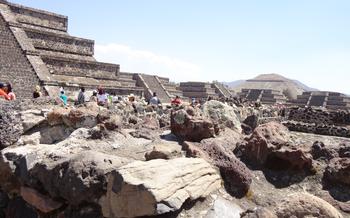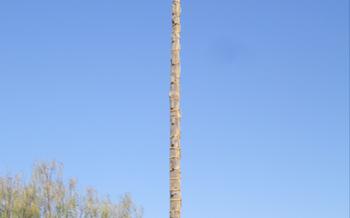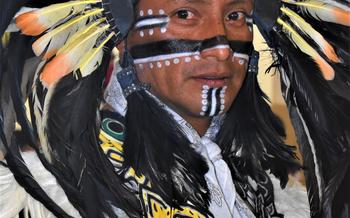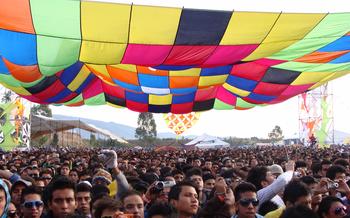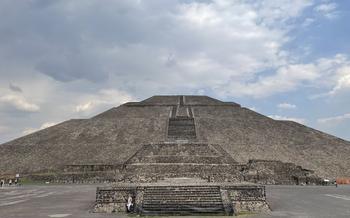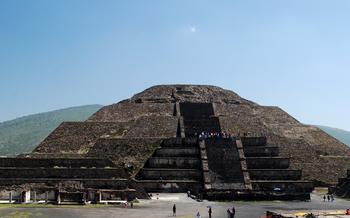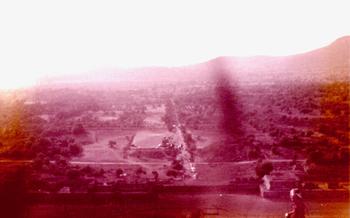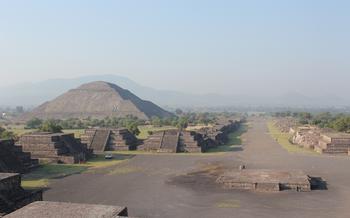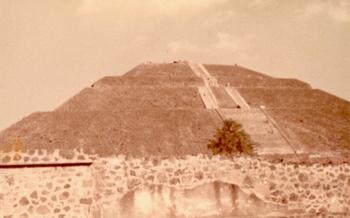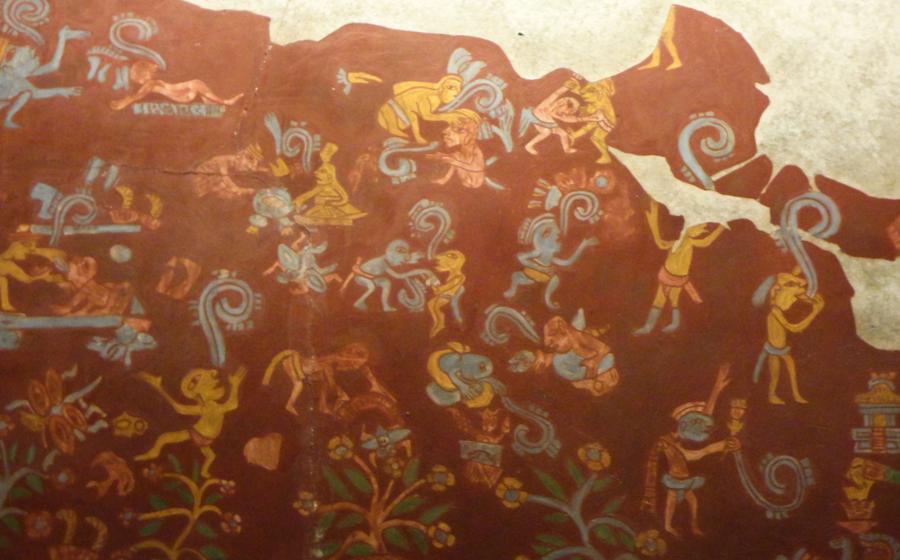
Anthropology Museum in Mexico City
- A Monumental City in the Valley of Mexico
- Exploring the Pyramids of the Sun and Moon
- Walking the Avenue of the Dead
- Exploring the Teotihuacan Murals
- Discovering the Teotihuacan Glyphs
- Visiting the Temple of Quetzalcoatl
- Exploring the Ciudadela Complex
- Visiting the Museum of Teotihuacan Culture
- Taking a Guided Tour
- Planning Your Visit
- Essential Travel Tips
- Exploring Beyond Teotihuacan
- Respecting the Cultural Heritage
- Capturing the Memories
- Insider Tip: Uncovering the Hidden Gem of Teotihuacan
A Monumental City in the Valley of Mexico
In the heart of Mexico, nestled in the Valley of Mexico, lies the ancient city of Teotihuacan, a testament to the ingenuity and cultural achievements of Mesoamerican civilization. Dating back to the 1st century BC, Teotihuacan flourished for over 600 years, leaving behind a legacy of monumental architecture, intricate artwork, and a complex social and political system.
The city's strategic location played a pivotal role in its development. Situated on a fertile plain with access to abundant water resources, Teotihuacan became a hub for trade and commerce, connecting various regions of Mesoamerica. Its central position also facilitated cultural exchange and the dissemination of ideas, making it a melting pot of diverse influences that shaped the city's unique identity.
As a major religious and cultural center, Teotihuacan attracted pilgrims and visitors from far and wide. The city's awe-inspiring pyramids, dedicated to the sun and moon deities, served as focal points of worship and pilgrimage. These structures, along with other monumental buildings, reflected the city's deep spiritual beliefs and connection to the cosmos.
In 1987, UNESCO recognized the outstanding universal value of Teotihuacan, designating it as a World Heritage Site. Today, the city stands as a symbol of Mexico's rich cultural heritage, inviting visitors to explore its mysteries and marvel at the achievements of its ancient inhabitants.
Anecdote:
My first encounter with Teotihuacan was a breathtaking experience. As I approached the site, the sheer scale of the pyramids filled me with awe. Climbing the Pyramid of the Sun, I felt a profound connection to the past, imagining the thousands of pilgrims who had made the same journey centuries before. From the summit, the panoramic view of the city and the surrounding valley was simply mesmerizing, leaving me with a sense of wonder and admiration for the people who built this incredible metropolis.
Exploring the Pyramids of the Sun and Moon
The Pyramids of the Sun and Moon stand as the most iconic and awe-inspiring structures of Teotihuacan. The Pyramid of the Sun is the largest pyramid in the city, and its sheer size is a testament to the ingenuity and engineering prowess of the Teotihuacanos. It rises an impressive 216 feet (66 meters) into the sky and covers an area of over 22 acres (9 hectares). Its construction involved the movement of an estimated 2 million tons of stone and earth, making it one of the largest pyramids built anywhere in the world.
The Pyramid of the Moon, while smaller in size, is no less significant. It stands at 150 feet (46 meters) tall and boasts a unique feature - a large plaza at its base that was used for religious ceremonies and rituals. Both pyramids are believed to have been built as tombs for Teotihuacan's rulers or as temples dedicated to important deities.
Ascending the Pyramid of the Sun is a challenging but rewarding experience. The steep steps require stamina and careful footwork, but the panoramic views from the top are simply breathtaking. The vast expanse of Teotihuacan unfolds before you, with the Pyramid of the Moon, the Avenue of the Dead, and the surrounding mountains forming a mesmerizing backdrop. It's a moment that encapsulates the grandeur and majesty of this ancient city, making it an unforgettable experience for any visitor.
Walking the Avenue of the Dead
The Avenue of the Dead, the main thoroughfare of Teotihuacan, is a testament to the city's grand design and urban planning. Stretching for over two miles, the avenue connects the Pyramid of the Sun and the Pyramid of the Moon, forming a central axis that divides the city into two symmetrical halves.
Along the avenue, visitors can admire an array of impressive monuments and structures that showcase the architectural prowess of the Teotihuacanos. The Temple of Quetzalcoatl, with its iconic feathered serpent sculptures, stands out as one of the most notable landmarks. The Ciudadela, a vast complex with a large pyramid at its center, further demonstrates the city's architectural sophistication.
During my visit, I had the privilege of meeting a local guide who shared fascinating insights about the Avenue of the Dead. He explained that the avenue was not just a ceremonial route but also served as a bustling marketplace and a gathering place for the city's inhabitants. The guide pointed out the remains of shops and workshops lining the avenue, where artisans and merchants once plied their trade.
Strolling along the Avenue of the Dead, I couldn't help but marvel at the vision and ingenuity of the Teotihuacanos. Their ability to create such a grand and harmonious urban space is a testament to their advanced civilization and their profound understanding of urban planning.
Exploring the Teotihuacan Murals
The Teotihuacan murals are a testament to the artistic prowess and cultural significance of this ancient civilization. They adorn the walls of various structures throughout the site, offering vibrant glimpses into the beliefs, rituals, and daily life of the Teotihuacanos.
Common themes depicted in the murals include gods, animals, and human activities. The gods are often portrayed with elaborate headdresses and adorned with precious jewels, symbolizing their divine status. Animals such as jaguars, coyotes, and owls are frequently featured, representing the sacred connection between humans and the natural world. Scenes of everyday life depict hunting, farming, and religious ceremonies, providing valuable insights into the social and cultural dynamics of Teotihuacan.
One particularly striking mural, located in the Temple of Quetzalcoatl, depicts a procession of priests carrying a large, ornate palanquin. The priests are dressed in elaborate costumes and wear feathered headdresses, indicating their high status within the society. The palanquin is adorned with colorful feathers and precious stones, suggesting that it contains a sacred object or deity.
The murals of Teotihuacan are a priceless legacy that offers a window into the past. They are a testament to the creativity and artistry of this ancient civilization and continue to captivate and inspire visitors from around the world.
Discovering the Teotihuacan Glyphs
The Teotihuacanos developed a sophisticated writing system consisting of a combination of logographic and syllabic signs. These glyphs, often found on monuments, murals, and artifacts, provide valuable insights into their language, culture, and history. While the complete decipherment of the Teotihuacan script remains a challenge, scholars have made significant progress in understanding its basic structure and vocabulary.
One of the most intriguing aspects of the Teotihuacan glyphs is their artistic and symbolic nature. They often incorporate intricate designs, human figures, and animal motifs, creating a visually appealing and meaningful form of communication. Common themes depicted in the glyphs include religious beliefs, mythological narratives, historical events, and everyday life.
In my exploration of Teotihuacan, I came across a particularly striking glyph carved on a stone slab. It featured a stylized human figure with elaborate headdress, surrounded by a series of abstract symbols. Intrigued by its complexity, I spent a considerable amount of time studying the glyph, trying to decipher its meaning. While I couldn't fully unravel its secrets, the process deepened my appreciation for the sophistication and artistry of Teotihuacan's written culture.
Visiting the Temple of Quetzalcoatl
The Temple of Quetzalcoatl, also known as the Temple of the Feathered Serpent, is one of the most iconic and visually striking structures in Teotihuacan. Dedicated to the god Quetzalcoatl, the temple showcases the Teotihuacanos' architectural prowess and artistic sensibility.
Built on a raised platform, the temple features a series of intricate carvings and sculptures depicting the feathered serpent deity. The facade is adorned with colorful murals and friezes, showcasing scenes from mythology and daily life. The most notable feature of the temple is its grand staircase, flanked by two colossal serpent heads that seem to emerge from the earth.
One unforgettable anecdote from my visit to the Temple of Quetzalcoatl occurred during a conversation with a fellow traveler. As we admired the intricate carvings, he shared his theory about the symbolism of the temple. According to him, the feathered serpent represented the duality of life and death, with the temple serving as a portal between the two realms. His insights added a profound layer of meaning to my experience, reminding me of the rich spiritual and cultural significance embedded within Teotihuacan's architecture.
Exploring the Ciudadela Complex
History and Significance:
The Ciudadela complex stands as a testament to the remarkable engineering and architectural prowess of the Teotihuacanos. Once a vibrant hub of activity, it served as a ceremonial and administrative center, hosting religious rituals, political gatherings, and bustling marketplaces. Its strategic location at the heart of Teotihuacan reflects its importance as a crucial node in the city's urban fabric.
Description of Structures:
The Ciudadela complex encompasses a vast array of structures, each playing a distinct role in the city's functioning. The most prominent feature is the Pyramid of the Feathered Serpent, a colossal edifice adorned with intricate carvings depicting the mythical serpent deity, Quetzalcoatl. The pyramid's imposing presence dominates the complex, symbolizing the divine power and authority vested in the city's rulers.
Personal Anecdote:
As I stood atop the Pyramid of the Feathered Serpent, gazing out over the sprawling expanse of Teotihuacan, a profound sense of awe washed over me. The panoramic vista revealed a cityscape meticulously planned and aligned with celestial bodies, reflecting the deep spiritual connection the Teotihuacanos held with the cosmos. In that moment, I felt a tangible connection to the past, transported back in time to witness the grandeur and majesty of this ancient civilization.
Visiting the Museum of Teotihuacan Culture
Established in 1980, the Museum of Teotihuacan Culture (Museo de la Cultura Teotihuacana) is a must-visit for those seeking a deeper understanding of Teotihuacan's rich history and legacy. Located just outside the archaeological site, the museum houses a remarkable collection of artifacts, pottery, sculptures, and murals that provide valuable insights into the daily lives, beliefs, and artistic achievements of the Teotihuacanos.
Visitors can marvel at intricate ceramic vessels adorned with colorful designs, stone sculptures depicting deities and rulers, and beautifully preserved murals that once adorned the walls of Teotihuacan's temples and palaces. The museum's exhibits are arranged chronologically, allowing visitors to trace the evolution of Teotihuacan culture from its humble beginnings to its rise as a powerful city-state.
One particularly memorable encounter occurred during a visit to the museum. I had the privilege of meeting a curator who shared fascinating insights into the museum's recent discoveries. He spoke passionately about the ongoing archaeological research at Teotihuacan and the challenges of interpreting the enigmatic symbols and glyphs found throughout the site. His enthusiasm was contagious, and I left the museum with a newfound appreciation for the complexity and sophistication of Teotihuacan culture.
Taking a Guided Tour
When visiting Teotihuacan, consider embarking on a guided tour to unlock the secrets of this ancient city. Guided tours offer several advantages, including access to restricted areas not accessible to the general public. Expert guides provide invaluable knowledge, bringing the history, culture, and significance of Teotihuacan to life. They can point out intricate details, explain the symbolism behind the architecture, and narrate the stories and legends associated with the site.
To find reputable tour operators, conduct thorough research online or seek recommendations from your hotel or hostel. Look for companies with experienced and knowledgeable guides, positive reviews, and a good safety record. Consider the length and itinerary of the tour to ensure it aligns with your interests and time constraints.
I had the privilege of taking a guided tour with a passionate and engaging guide named Carlos. His enthusiasm for Teotihuacan was contagious, and his storytelling abilities transported me back in time. He shared fascinating insights into the city's construction, its religious beliefs, and its daily life. Thanks to Carlos, my visit to Teotihuacan became an unforgettable and immersive experience.
Planning Your Visit
When planning your visit to Teotihuacan, timing is key. The best time to visit is during the shoulder seasons (April-May and September-October) when the weather is pleasant, and the crowds are smaller. During the peak season (November-March), the site can be packed with tourists, making it difficult to fully appreciate the ancient city's grandeur.
To make the most of your visit, arrive early in the morning to beat the heat and the crowds. This will give you ample time to explore the site at your own pace and capture stunning photographs without hordes of people in the background.
Once you're at Teotihuacan, comfortable shoes are a must. You'll be doing a lot of walking on uneven surfaces, so sturdy footwear is essential. Also, don't forget your sunscreen, sunglasses, and a hat to protect yourself from the sun's intense rays.
As you navigate the site, follow the recommended routes to ensure you see all the major highlights, including the Pyramid of the Sun, the Pyramid of the Moon, the Avenue of the Dead, and the Temple of Quetzalcoatl. Don't miss the Teotihuacan Murals, which offer a glimpse into the city's rich artistic heritage.
And if you're feeling adventurous, venture off the beaten path to explore some of the lesser-known areas of Teotihuacan. There are hidden gems waiting to be discovered, such as the Palace of the Jaguars and the Temple of Agriculture.
As you wander through this ancient city, let your imagination run wild. Picture the bustling streets, the vibrant colors, and the rituals that once took place here. Teotihuacan is a place where history comes alive, and memories are made to last a lifetime.
Essential Travel Tips
Packing for Success:
When packing for your Teotihuacan adventure, practicality is key. Ensure you have comfortable shoes for walking on uneven terrain, sunscreen to protect your skin from the intense Mexican sun, and a hat to shield your head from the heat. A water bottle is essential to stay hydrated, and consider bringing snacks to keep your energy levels up throughout the day.
Transportation Options:
Reaching Teotihuacan from Mexico City is relatively easy. Public buses offer a budget-friendly option, departing from the Central del Norte bus station. Taxis are also readily available, providing a more direct and comfortable journey. If you prefer a guided experience, consider booking a tour that includes transportation to and from your hotel.
Exploring on Two Wheels:
For a unique and adventurous experience, rent a bicycle and explore the surrounding countryside. This allows you to venture beyond the main attractions and discover hidden gems at your own pace. Just remember to stay hydrated and be mindful of the traffic.
Anecdote: A Serendipitous Discovery:
During my visit, I spontaneously decided to rent a bicycle and explore the area surrounding Teotihuacan. As I pedaled along a quiet country road, I stumbled upon a hidden cenote, a natural swimming hole surrounded by lush vegetation. It was a refreshing and unexpected oasis that made the bicycle rental all the more worthwhile.
Exploring Beyond Teotihuacan
While Teotihuacan stands as a captivating destination in its own right, the surrounding region of Mexico City offers a wealth of additional cultural and historical treasures waiting to be explored. For those seeking a more comprehensive experience, consider venturing beyond the ancient city to discover these hidden gems.
A short distance from Teotihuacan lies the Basilica of Guadalupe, a revered pilgrimage site that attracts millions of visitors each year. This stunning cathedral is dedicated to the Virgin of Guadalupe, Mexico's patron saint, and holds a profound spiritual significance for many Mexicans. Take time to explore the basilica's beautiful architecture, admire its sacred artwork, and soak in the atmosphere of devotion that permeates the air.
Another must-visit destination near Teotihuacan is Xochimilco, a UNESCO World Heritage Site known for its enchanting floating gardens. This unique network of canals and man-made islands offers a glimpse into Mexico's rich cultural heritage and traditions. Embark on a traditional boat ride through the canals, marvel at the colorful flowers and vegetation, and savor the flavors of delicious local cuisine.
To create a well-rounded itinerary, consider combining your visit to Teotihuacan with these nearby attractions. Plan a multi-day trip that allows you to delve into the ancient history of Teotihuacan while also experiencing the vibrant culture and natural beauty of the surrounding area. You'll leave Mexico City with a deeper appreciation for the country's rich heritage and diverse offerings.
Anecdote:
On my first trip to Mexico City, I had the good fortune of meeting a local who shared his favorite hidden spot near Teotihuacan. He led me to a secluded hilltop overlooking the ancient city, offering a breathtaking panoramic view that took my breath away. As I stood there, surrounded by the tranquility of nature, I felt a profound connection to the history and grandeur of Teotihuacan. It was a moment I will cherish forever, reminding me of the unexpected treasures that await those who venture beyond the beaten path.
Respecting the Cultural Heritage
As you embark on your journey to Teotihuacan, it is imperative to approach the site with a profound sense of respect and reverence for its cultural significance. This ancient city holds immense value not only as a historical relic but also as a living testament to the ingenuity and artistry of the Teotihuacan civilization.
When visiting Teotihuacan, it is crucial to adhere to proper etiquette and guidelines to ensure the preservation and protection of this sacred site for generations to come. Appropriate attire is essential, as revealing or disrespectful clothing is not permitted. Moreover, climbing on the pyramids is strictly prohibited, as this can cause damage to these delicate structures.
By respecting the cultural heritage of Teotihuacan, we honor the legacy of the ancient civilization that built it and contribute to the preservation of this awe-inspiring wonder for future generations. During my visit, I had the privilege of meeting a local guide who shared heartfelt stories about the importance of cultural heritage and the community's efforts to protect Teotihuacan. His passion and dedication left a lasting impression on me, reinforcing the significance of treating this site with the utmost respect.
Capturing the Memories
Teotihuacan's grandeur and mystique are best immortalized through photography. Capture the towering pyramids against the vast Mexican sky, their silhouettes casting long shadows across the ancient city. Experiment with different angles to convey the scale and majesty of these structures. For a unique perspective, climb to the top of the Pyramid of the Sun and shoot panoramic vistas that encompass the entire site. Remember to play with lighting conditions; the golden hues of sunrise and sunset bathe Teotihuacan in a magical glow.
In addition to capturing the iconic landmarks, don't overlook the intricate details that bring Teotihuacan to life. Zoom in on the vibrant murals adorning the Temple of Quetzalcoatl, capturing the intricate patterns and colors that tell stories of ancient gods and legends. Photograph the weathered glyphs etched into stone, each symbol holding secrets of a long-lost civilization. Through your lens, you can bring the spirit of Teotihuacan back to life, sharing its timeless beauty with the world.
Anecdote:
During my visit, I stumbled upon a hidden corner of Teotihuacan, where a lone cactus stood against the backdrop of the Pyramid of the Moon. The cactus, with its arms reaching towards the sky, seemed to be paying homage to the ancient city. I captured this moment, the juxtaposition of the ancient and the living, and it remains one of my favorite photographs from Teotihuacan.
Insider Tip: Uncovering the Hidden Gem of Teotihuacan
Beyond the iconic pyramids and bustling tourist areas, Teotihuacan holds a hidden gem that offers a unique and tranquil experience. Tucked away in the northeastern corner of the site, the Teotihuacan Botanical Garden is an oasis of natural beauty and cultural significance.
Established in 1983, the garden showcases a diverse collection of plants that were significant to the ancient Teotihuacanos. Visitors can wander through themed sections, each representing a different aspect of the city's history and culture. From medicinal plants to edible species, the garden offers a glimpse into the daily life and traditions of the ancient inhabitants.
One of the highlights of the garden is the Ethnobotanical Museum, which houses a collection of artifacts and tools used by the Teotihuacanos for agriculture, medicine, and rituals. Visitors can learn about the various plant species that were cultivated and used by the ancient civilization, gaining a deeper understanding of their connection to the natural world.
The garden is also a haven for wildlife, providing a habitat for numerous bird species, butterflies, and other small animals. Visitors can take a leisurely stroll along the garden paths, enjoying the tranquility of the surroundings and the opportunity to observe the local fauna.
To make the most of your visit, plan to spend at least a few hours exploring the garden. The best time to visit is early in the morning or late in the afternoon, when the temperatures are more pleasant. Remember to bring comfortable shoes, water, and a camera to capture the beauty of this hidden gem.
